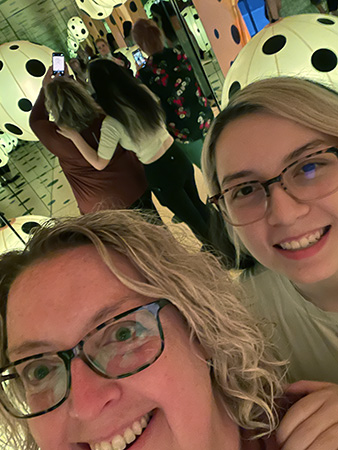
The power of partnerships: Helping teens conquer chronic pain
Ella Yee’s journey with chronic pain began in sixth grade, a year filled with headaches, stomachaches and inexplicable vomiting. Once she reached high school, she felt even worse. Frequent pain, dizziness and nausea caused her to miss 20 days of school during the first semester of her sophomore year.
Eventually Ella got answers — she was diagnosed with migraines, irritable bowel syndrome and postural orthostatic tachycardia syndrome (POTS) — but no relief.
"I felt miserable,” said Ella. “I didn’t hang out with friends and family and isolated myself in my room a lot.”
Then Ella’s family learned about the Integrated Healing Program, a collaboration between Children’s Wisconsin and Rogers Behavioral Health. Designed to help teens ages 13-18 overcome chronic pain and functional impairments, the program is the only one of its kind in Wisconsin and one of just a few such programs across the country.
While the Integrated Healing Program mostly draws patients from Wisconsin and nearby states, the program has already received inquiries from families as far away as New York, Georgia and California.
For four to six weeks, teens attend an intensive outpatient program from 8 a.m.-4 p.m. every weekday. The program includes individual and group physical therapy, individual and group counseling, health psychology sessions and parent education.
Since the program launched in May 2021, more than 100 teens have participated with impressive results: More than 90 percent report overall improvement after the program. Participants report significant improvements in their physical functioning and return to age-appropriate activities, quality of life and emotional well-being, as well as being less worried about their pain and how it will affect them. And almost every teen who has come in using medical equipment to get around — from wheelchairs to walkers — has ditched the equipment by the program’s end.
“There have been kids who have been literally in their beds for the last six months because of the depression and chronic pain,” said Kimberly Anderson Khan, PsyD, a Children’s Wisconsin psychologist who works with the Integrated Healing Program. “Then they come to the program and they’re moving, interacting with peers, and eventually, returning to school and life. And we see that change so much more quickly than we do in the typical outpatient setting.”
Healing the mind and body
 Steven Weisman, MD, medical director of the Jane B. Pettit Pain and Headache Center at Children’s Wisconsin, had dreamed of starting the Integrated Healing Program for years.
Steven Weisman, MD, medical director of the Jane B. Pettit Pain and Headache Center at Children’s Wisconsin, had dreamed of starting the Integrated Healing Program for years.
“Those of us who have been seeing kids with chronic pain for a really long time know there is a relatively small, but important, subset of kids who fail standard, straightforward outpatient treatment,” said Dr. Weisman. “They’re not doing what they need to do to live as normal teenagers. The most obvious impairment is that they stop going to school or they create a construct of school that really isn’t going to prepare them for success, like only attending partial days. So it’s socially isolating, it’s emotionally isolating and it’s contributing to their physical inactivity, which then amplifies their chronic pain challenge.”
Before the Integrated Healing Program, Children’s Wisconsin would sometimes refer patients to intensive pain rehabilitation programs out of state. But as Children’s Wisconsin invested more in pediatric mental and behavioral health services to meet the urgent need, pain specialists realized there was an opportunity to partner with Rogers Behavioral Health to help more kids closer to home.
The Integrated Healing Program aims to rewire pain pathways and break the vicious pain cycle by using an intensive, multidisciplinary approach. The Children’s Wisconsin team brings expertise in pain management and health psychology, while the Rogers team specializes in cognitive behavioral therapy and dialectical behavior therapy to treat chronic pain and the anxiety and/or depression that teens with chronic pain often experience. The fact that the Integrated Healing Program is based at a behavioral health center like Rogers and focuses so much on mental and behavioral health makes it unique in the national landscape.
“Our program focuses more on trying to prepare the kids to be psychologically and behaviorally empowered and sound, because we believe that is a critical part of their long-term benefit and recovery,” said Dr. Weisman.
Physical therapy is another crucial component. Instead of a typical outpatient program that might be once or twice a week, teens have two sessions of physical therapy every weekday. Most patients start seeing the difference in the very first week.
"The outcomes have surpassed even our expectations,” said Jill Wenzel, manager of the Jane B. Pettit Pain and Headache Center. “Physical therapy contributes a huge part to their functional gains because they’re moving their bodies. They’re basically retraining their muscles and building their muscles back up again.”
Supporting teens and parents
 Dr. Khan leads health psychology sessions to help teens understand how pain works and the factors that can influence it. Chronic pain is a complex issue that intertwines biological, psychological and social factors.
Dr. Khan leads health psychology sessions to help teens understand how pain works and the factors that can influence it. Chronic pain is a complex issue that intertwines biological, psychological and social factors.
“Pain is a sensory experience and involves both the physical and the emotional experience of pain, which is negative 100 percent of the time,” said Dr. Khan. “You never wake up with a headache and think, ‘Oh, yay, it’s going to be a great day.’ And for a lot of kids, pain is incredibly stressful.”
She also leads group sessions for parents. One of the lessons she imparts is that focusing on kids’ pain and providing special accommodations can be well intended but counter-productive.
“There are a lot of things that we do as parents that are sort of intuitive based on how you would treat your child who has the flu or a broken leg. But chronic pain is backwards,” she said. “Rest actually makes it worse because kids become deconditioned and then it hurts more to move. Kids often times become quite isolated, and it’s more anxiety-provoking to get back out into the world. We encourage parents to do less and let the kids start to take ownership. The result is that kids start to feel more confident, stronger, more capable once they start to reengage with regular things that typical 15-year-olds would do.”
For Ella and her family, the parent education was transformational. “Everything I was trying to do to help her ended up almost hurting her more,” said Ella’s mom, Sarah. “Just having a much better understanding of chronic pain made a big difference. And even now when she has a flare-up, I think we manage it very differently than we would’ve in the past.”
Changing teens’ lives
The program isn’t the right fit for every patient.
“Readiness for the program is essential,” said Jill. “When patients and their families are truly ready, then patients do extremely well.”
And Ella is among them. As soon as Ella started the program in July 2023, her mom noticed she was more talkative and willing to hang out.
“It was little successes that happened very quickly and just progressively got stronger and stronger. But I would say the big shift happened after the second week,” said Sarah. Ella’s symptoms flared up, but she was still required to attend the program. The team taught her coping mechanisms — like breath work, taking a short walk, and changing her scenery — to power through her pain.
“They were very hands-on and kind,” said Ella.
But Ella also put in the work. “What set her up for success is she came in with a really open mind and pretty quickly started to make some significant lifestyle changes,” said Dr. Khan.
Within two weeks, Ella noticed improvements in her motivation, mood, functioning and energy levels. During her third week, Ella told Dr. Khan with excitement: “I am running on the treadmill!” It was something she never could have imagined at the beginning of the program, and it gave her hope that she could return to volleyball, basketball and other activities. Because teens are admitted on a rolling basis, new patients get inspired by peers who are farther along. They also get a chance to bond with other teens who understand their challenges.
“It showed me I’m not the only one struggling and that there are other people like me that I can talk to about pain,” said Ella.
Helping more kids like Ella
The Integrated Healing Program has been such a success that program leaders hope to grow its impact. They recently increased their capacity and may eventually add a separate track for younger kids and/or other complex medical and behavioral conditions.
In addition to teens with chronic pain, the program has also expanded to serve patients with functional neurological disorders, such as gait problems that don’t have a known medical cause.
“We would like to see how we can help more patients in need,” said Jill.
At Children’s Wisconsin, physicians and staff and dedicated to continuous learning and improvement. In fact, Dr. Weisman and Dr. Khan are both faculty at the Medical College of Wisconsin — the academic partner of Children’s Wisconsin — where they teach the next generation of providers. Having such a close connection to academic medicine empowers and inspires Dr. Weisman and Dr. Khan, and all specialty providers at Children’s Wisconsin, to constantly be pushing the boundaries of what is possible.
Meanwhile, Ella has returned to school with a whole new set of tools. She’s thriving in class, busy with extracurricular activities and friends, and goofing around with her family and two dogs when she’s at home. She still has the occasional flare-up of symptoms, but her mom doesn’t even bother to track it anymore because Ella isn’t letting the pain interfere with her life.
“Since she’s been out of the program, her humor and her laughter and her joy is back. We wouldn’t have gotten there without the Integrated Healing Program,” said Sarah. “We get to see Ella, and we haven’t seen her for years.”
Children's Wisconsin Resources

Written by
Nicole Sweeney Etter
Writer
Related Stories
No related articles found.



